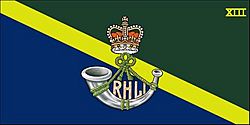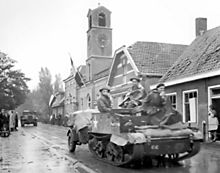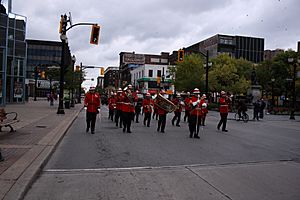The Royal Hamilton Light Infantry (Wentworth Regiment) facts for kids
Quick facts for kids The Royal Hamilton Light Infantry(Wentworth Regiment) |
|
|---|---|
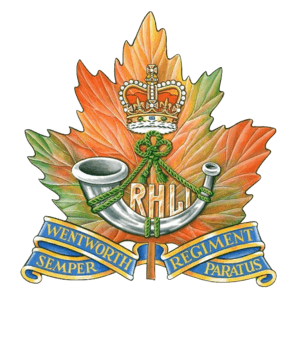
Cap badge of the regiment
|
|
| Active | 1862–present |
| Country | |
| Branch | |
| Type | Light Infantry |
| Role | Light Infantry |
| Size | Battalion |
| Part of | 31 Canadian Brigade Group |
| Garrison/HQ | John Weir Foote VC Armoury 200 James Street North Hamilton, Ontario |
| Nickname(s) | The Rileys |
| Motto(s) | Semper Paratus (Always Ready) |
| March | Quick: Mountain Rose |
| Commanders | |
| Current commander |
LCol A. Colic |
| Colonel-in-chief | Vacant |
| Honorary Colonel | Don Cranston |
| Honorary Lieutenant-Colonel | Glenna Swing |
The Royal Hamilton Light Infantry (Wentworth Regiment) (RHLI) is a special kind of army unit in Canada. It's part of the Primary Reserve, which means its soldiers train part-time. The RHLI is based in Hamilton, Ontario, at the John Weir Foote VC Armoury. They are part of the Canadian Army and belong to the 31 Canadian Brigade Group.
Contents
What is the RHLI Badge?
Badge Description
The RHLI badge shows an autumn maple leaf. On the leaf is a silver bugle with the letters "RHLI" in gold. A royal crown sits on top. At the bottom, two blue scrolls have the words "WENTWORTH REGIMENT" and "SEMPER PARATUS" in gold letters.
Badge Symbolism
The maple leaf on the badge stands for service to Canada. The crown shows their loyalty to the King or Queen. The bugle represents that they are a "light infantry" unit, which means they are known for moving quickly. "RHLI" and "WENTWORTH REGIMENT" are parts of the unit's name. "SEMPER PARATUS" is their motto, which means "Always Ready" in Latin.
How the RHLI Began
The Royal Hamilton Light Infantry started in Hamilton, Ontario, on December 11, 1862. Back then, it was called the 13th Battalion Volunteer Militia (Infantry), Canada. Over the years, its name changed several times.
In 1927, it became the Royal Hamilton Light Infantry. Then, in 1936, it joined with another unit called the Wentworth Regiment. This is how it got its full name: The Royal Hamilton Light Infantry (Wentworth Regiment). People often call them "The Rileys" for short.
The Wentworth Regiment itself started in Dundas, Ontario, in 1872. It was first known as the 77th "Wentworth" Battalion of Infantry.
Who the RHLI Represents (Perpetuations)
The RHLI carries on the history of several older military units. This means they keep the traditions and battle honours of these groups alive.
War of 1812
- The 2nd Regiment of York Militia
First World War
- The 4th Battalion (Central Ontario), CEF
- The 86th Battalion (Machine Gun), CEF
- The 120th (City of Hamilton) Battalion, CEF
- The 129th (Wentworth) Battalion, CEF
- The 205th (Hamilton) Battalion, CEF
RHLI's Friends (Alliances)
The RHLI has a special friendship with a British army unit:
 United Kingdom - The Rifles
United Kingdom - The Rifles
RHLI in Action (Operational History)
The RHLI and its earlier units have served in many conflicts.
The Fenian Raids (1866)
The 13th Battalion Volunteer Militia was called to active duty in 1866. They fought on the Niagara frontier during the Fenian raids. These raids were attacks by Irish-American groups into Canada.
South African War (1899-1902)
During this war, many volunteers from the 13th Regiment joined Canadian forces fighting in South Africa.
The First World War (1914-1918)
The 77th Wentworth Regiment helped with local protection duties when the war started. The 4th Battalion, which the RHLI now represents, went to Britain in 1914 and then fought in France and Belgium until the war ended. Other battalions linked to the RHLI also helped by sending soldiers to the front lines.
The Second World War (1939-1945)
The RHLI formed an active service battalion in 1939. They went to Britain in 1940.
Their first major battle was the Dieppe Raid in France on August 19, 1942. This was a very tough day for the RHLI. Out of 582 soldiers who landed, only 102 were not hurt or captured. Many were killed or wounded. Even though it was a difficult battle, it helped the Allies learn important lessons for future invasions.
One of the most famous members of the RHLI from Dieppe was their chaplain, Honorary Captain John Foote. He stayed with the wounded and captured soldiers instead of leaving. He was later awarded the Victoria Cross, Canada's highest military honour, for his bravery.
The RHLI returned to France in July 1944, after D-Day. They fought through North-West Europe until the end of the war. They were known for holding their ground during a tough battle called Operation Spring.
After the Wars (Post-War)
After the Second World War, some RHLI soldiers served in the Korean War with the United Nations. Others served with NATO in Germany. The armoury in Hamilton was renamed the John Weir Foote VC Armoury to honour their brave chaplain.
From 1978 until his death in 2021, Prince Philip, Duke of Edinburgh, was the colonel-in-chief of the regiment. This is an honorary role.
War in Afghanistan (2002-2014)
Many RHLI soldiers volunteered to serve in Afghanistan between 2002 and 2014. This was the first time since the Second World War that members of the regiment took part in combat operations. They served in different roles, including infantry, support teams, and special operations.
RHLI Traditions
- The Rileys: Soldiers of the regiment are often called "Rileys" (sounds like R-H-L-I).
- Exercise Resolute Riley: This is an annual event where soldiers test their fitness and teamwork. It includes a tough swamp crossing, running, and a march with heavy backpacks.
- Silver Cap Badge: This award is given each year to the top soldier in different rank groups. The winners get to wear a special silver cap badge for a year.
- Ceremonial Troop: The RHLI has a special group called the 13th Battalion Ceremonial Guard. They perform public duties and ceremonies, often wearing historical uniforms.
Royal Hamilton Light Infantry Heritage Museum
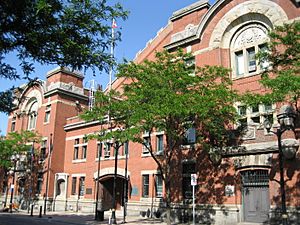 |
|
| Location | John Weir Foote VC Armoury 200 James Street North Hamilton, Ontario |
|---|---|
| Type | Regimental museum |
The RHLI has its own museum inside the John Weir Foote VC Armoury. The museum collects and displays items that tell the story of the regiment's long history. It helps to preserve their memories and achievements.
Notable Soldiers
- Denis Whitaker: He was a professional football player before the war. He became a commander in the RHLI during the Second World War and later a Brigadier. He also wrote many books about Canadian military history.
- Rev. John Wier Foote, VC: As mentioned, he won the Victoria Cross at Dieppe for helping wounded soldiers and staying with them even when captured.
- William Merrifield: Another recipient of the Victoria Cross.
Battle Honours
Battle honours are special awards given to military units for their bravery and service in battles or campaigns. The RHLI has earned many of these honours throughout its history. Those in bold are displayed on the regiment's flag.
War of 1812
- DEFENCE OF CANADA – 1812–1815
- DETROIT
- QUEENSTON
- NIAGARA
South African War
- SOUTH AFRICA, 1899–1900
First World War
- YPRES, 1915, '17
- ST. JULIEN
- FESTUBERT, 1915
- SOMME, 1916
- ARRAS, 1917, '18
- VIMY, 1917
- PASSCHENDAELE
- AMIENS
- HINDENBURG LINE
- PURSUIT TO MONS
- FRANCE AND FLANDERS, 1915–18
Second World War
- DIEPPE
- VERRIÈRES RIDGE–TILLY-LA-CAMPAGNE
- FALAISE
- CLAIR TIZON
- FORÊT DE LA LONDE
- THE SCHELDT
- WOENSDRECHT
- THE RHINELAND
- GOCH–CALCAR ROAD
- THE HOCHWALD
- XANTEN
- GRONINGEN
- NORTH-WEST EUROPE, 1942, 1944–1945
South-West Asia
- AFGHANISTAN
Royal Canadian Army Cadets
The RHLI supports two Royal Canadian Army Cadets corps. One is in Hamilton (62 Canadian Cadet Corps) and the other in Burlington (2379 Canadian Cadet Corps). These programs offer great training for young people. Many cadets from these corps have gone on to join the Canadian Armed Forces.



